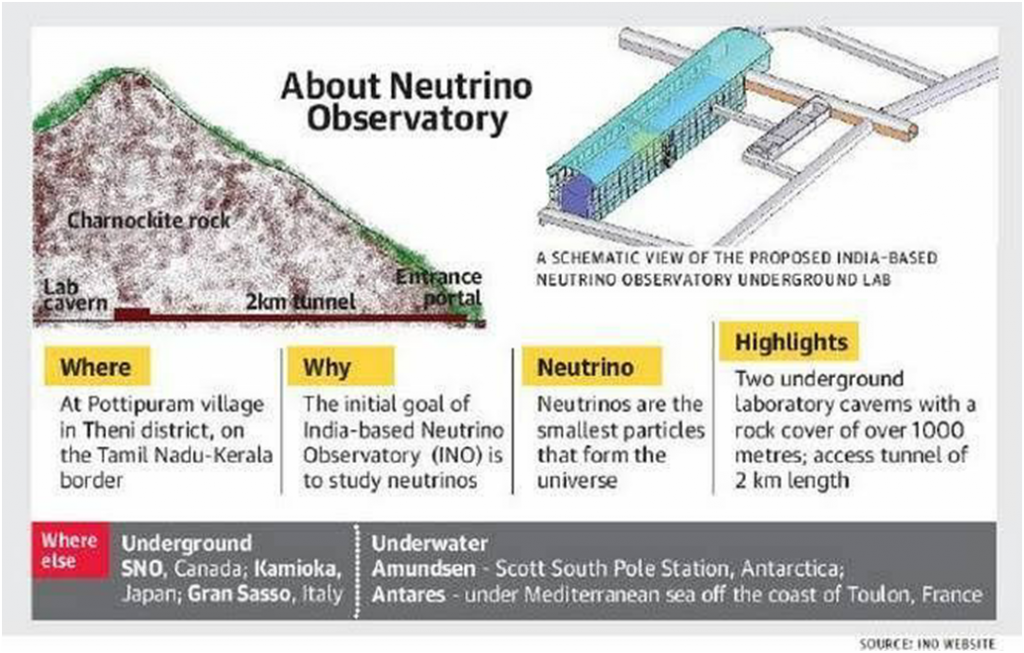CURRENT AFFAIRS
Get the most updated and recent current affair content on Padhaikaro.com
Neutrino project
- IAS NEXT, Lucknow
- 19, Feb 2022

Reference News:-
Tamil Nadu has made clear to the Supreme Court that it does not want the Indian Neutrino Observatory (INO) to be set up in a sensitive ecological zone in the Western Ghats at great cost to wildlife, biodiversity, and by ignoring the local opposition and public agitations to the project.
Why is it being opposed?
- The project in question falls exactly on the hill slopes of this part of the Western Ghats, which align within it a significant tiger corridor, namely the Mathikettan-Periyar tiger corridor.
- This corridor links the Periyar Tiger Reserve along the Kerala and Tamil Nadu borders and the Mathikettan Shola National Park.
- The proposed project area also ecologically links to the eastern habitats, where Srivilliputhur Meghamalai Tiger Reserve is located. It hosts tigers from this region and helps in genetic dispersal.
- The area is a significant watershed and catchment zone for the rivers Sambhal and Kottakudi.
About the project:
The India-based Neutrino Observatory (INO) Project is a multi-institutional effort aimed at building a world-class underground laboratory with a rock cover of approx.1200 m for non-accelerator based high energy and nuclear physics research in India. The initial goal of INO is to study neutrinos.
It is a mega-science project jointly funded by the Department of Atomic Energy (DAE) and the Department of Science and Technology (DST).
The project proposal includes:
- Construction of an underground laboratory and associated surface facilities at Pottipuram in Bodi West hills of Theni District of Tamil Nadu.
- Construction of an Iron Calorimeter (ICAL) detector for studying neutrinos.
- Setting up of National Centre for High Energy Physics at Madurai, for the operation and maintenance of the underground laboratory, human resource development and detector R&D along with its applications.
What are neutrinos?
Neutrinos, first proposed by Swiss scientist Wolfgang Pauli in 1930, are the second most widely occurring particle in the universe, only second to photons, the particle which makes up light. In fact, neutrinos are so abundant among us that every second, there are more than 100 trillion of them passing right through each of us — we never even notice them.
Neutrinos occur in three different types, or flavours. These are separated in terms of different masses. From experiments so far, we know that neutrinos have a tiny mass, but the ordering of the neutrino mass states is not known and is one of the key questions that remain unanswered till today. This is a major challenge INO will set to resolve, thus completing our picture of the neutrino.
Why detect them?
Neutrinos hold the key to several important and fundamental questions on the origin of the Universe and the energy production in stars. Another important possible application of neutrinos is in the area of neutrino tomograph of the earth, that is detailed investigation of the structure of the Earth from core on wards. This is possible with neutrinos since they are the only particles which can probe the deep interiors of the Earth.

Why should the laboratory be situated underground?
Neutrinos are notoriously difficult to detect in a laboratory because of their extremely weak interaction with matter.
- The background from cosmic rays (which interact much more readily than neutrinos) and natural radioactivity will make it almost impossible to detect them on the surface of the Earth. This is the reason most neutrino observatories are located deep inside the Earth’s surface.
- The overburden provided by the Earth matter is transparent to neutrinos whereas most background from cosmic rays is substantially reduced depending on the depth at which the detector is located.